RAF officer ranks
The officer ranks of the Royal Air Force, as they are today, were introduced in 1919. Prior to that Army ranks were used.
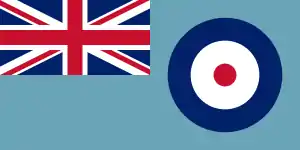 |
| Royal Air Force of the British Armed Forces |
|---|
| Components |
|
| History |
|
|
| Aircraft |
| Structure |
| Personnel |
Ranks
| NATO Code | OF-10 | OF-9 | OF-8 | OF-7 | OF-6 | OF-5 | OF-4 | OF-3 | OF-2 | OF-1 | OF(D) | |
|---|---|---|---|---|---|---|---|---|---|---|---|---|
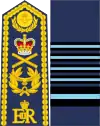 |
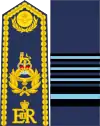 |
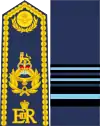 |
 |
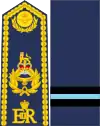 |
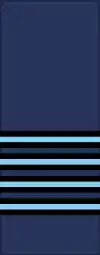 |
 |
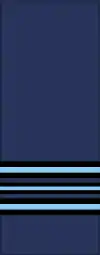 |
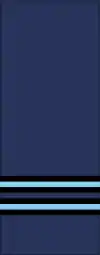 |
 |
 |
 | |
| Rank Title: | Marshal of the Royal Air Force | Air Chief Marshal | Air Marshal | Air Vice-Marshal | Air Commodore | Group Captain | Wing Commander | Squadron Leader | Flight Lieutenant | Flying Officer | Pilot Officer/ Acting Pilot Officer | Officer Cadet |
| Abbreviation: | MRAF[note 1] | Air Chf Mshl | Air Mshl | AVM | Air Cdre | Gp Capt | Wg Cdr | Sqn Ldr | Flt Lt | Fg Off | Plt Off | Off Cdt |
Notes
- The rank of Marshal of the Royal Air Force has become an honorary/posthumous rank, war time rank; ceremonial rank.
Origins
Lieutenant General David Henderson originally proposed that Royal Air Force officers use a combination of British Army and Royal Navy ranks. However, the War Office argued that the RAF should have its own ranks and the Admiralty opposed any use of their rank titles.[1]
Badges of rank
On 1 April 1918, Air Force Memorandum 2 specified rank insignia for the newly established independent force. Rank was to be worn on the jacket cuff and was derived from the Royal Navy's rings, each equivalent rank having the same number of rings. However, second lieutenants (now pilot officers) displayed a crowned eagle only and the Navy's loop was not used for any rank.[2] Depending on the uniform, either gold or pale blue on grey braid was worn.
In August 1918, Air Ministry Weekly Order 617 added a single band of 1⁄4-inch (6 mm) braid below the second lieutenant's eagle and all other officer ranks also received a crowned eagle above their braid on the left arm only.
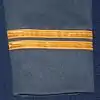
In 1919 the colour of the rank braid was changed to black with a central pale blue stripe. However, on RAF mess dress rank continued to be displayed in gold.
Sleeve ranks
The ranks worn on the sleeve are common to all RAF uniform variants incorporating the Jacket. The centre of the rank (measured from the bottom of the lowest braid to the top of the highest) should be 3 3⁄4 inches (9.5 cm) from the cuff and each row of braiding should have a space of 1⁄8 inch (3 mm) from other rows. The thinnest braid, as found on the pilot officer's rank (and in the middle of the squadron leader's rank), is 1⁄4 inch (6 mm); the flying officer's braid common to all the ranks except air commodore and pilot officer, is 1⁄2 inch (1.3 cm), and the thickest braid, as found on all air officer ranks, is 2 inches (5.1 cm).
Shoulder boards
 Air officers' ceremonial shoulder board | 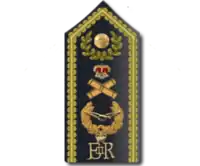 Shoulder board of marshal of the RAF |
Shoulder boards (as shown) are worn by officers of general rank equivalent (air commodore and above). Officers entitled to wear aiguillettes or the Royal Cypher, AVMs and above, the Director of Nursing Services, and those officers assigned to certain one-star posts, wear plain blue shoulder boards when in No 1 Service Dress. AVMs and above and those officers assigned to the one-star posts of commandant RAFC Cranwell, Air Officer Wales and Air Officer Scotland wear distinctive unranked ceremonial shoulder boards when in No 1A (ceremonial day) dress. If these officers wear a greatcoat, gold ranked shoulder straps in Crombie material are used.[3] Officers of the rank of marshal of the Royal Air Force have a distinctive set of shoulder boards with greater decoration.
Rank titles
It was initially proposed that each RAF officer rank would be either the equivalent army rank (used by the Royal Flying Corps) or the naval rank (used by the Royal Naval Air Service (RNAS). However, when the Royal Navy and British Army were consulted they made differing objections: the navy was unhappy that another service might use the names of its higher ranks, such as admiral, and the army objected to the RAF sharing the ranks assigned to junior officers. This resulted in a second proposed system, which made frequent use of the neologism ardian, which was derived from the Gaelic ard "chief" and eun "bird". Under this proposal the names were to have been: ensign, lieutenant, flight leader, squadron leader, reeve, banneret, fourth ardian, third ardian, second ardian, ardian and air marshal. A further proposal was: ensign, lieutenant, flight-leader, squadron-leader, wing-leader, leader, flight ardian, squadron ardian, wing ardian, ardian, air marshal. However, this system was rejected within the RAF, due in part to dislike of the neologism ardian.
On 1 August 1919, Air Ministry Weekly Order 973 introduced the official rank titles for RAF officers. Initially, the highest Air Officer rank was named "Marshal of the Air". However, a few days after this was promulgated, it was changed to Marshal of the Royal Air Force; this occurred reputedly at the request of King George V, who believed that the original name implied the powers of a deity. These were often modified versions of Royal Navy terms and in many cases represented a continuation of particular RNAS appointment titles, i.e. a role/command specific to a particular rank. For example, the new RAF rank of Flight Lieutenant had previously been the name of a RNAS appointment, held only by qualified pilots with the naval rank of Lieutenant; a RNAS observer with the same rank was instead known as an "observer lieutenant". The RAF rank of Squadron Leader was derived from a RNAS appointment, "squadron commander", which had been held by either a naval Lieutenant-Commander or Lieutenant.
Composite braid
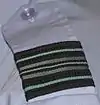
RAF officers typically wear composite braid rank slides with their working and operational uniforms. Composite braid consists of a single piece of fabric, where the "background" between the rank rings is made from blue-grey or olive green material. Composite braid rank slides are often referred to as "bar-code" in RAF slang.
Command flags
MRAF |
Air Chf Mshl |
Air Mshl |
AVM |
Air Cdre |
Gp Capt |
Wg Cdr |
Sqn Ldr |
Distinction between ranks and appointments
Many RAF ranks do not imply the appointment or duties of an officer. For example, a pilot officer may well not be trained to pilot an aircraft. In fact, pilots skip the rank of pilot officer and go from officer cadet to flying officer on graduation from officer training school at RAF Cranwell. A squadron leader does not necessarily command a squadron, nor a wing commander necessarily command a wing, nor a group captain command a group.
RAF Air Cadets (Air Training Corps and Combined Cadet Force)
The majority of officers in the Air Cadet Organisation (the Air Training Corps and the RAF section of the Combined Cadet Force) are volunteers commissioned into RAF Air Cadets and then appointed to service with the Air Training Corps or Combined Cadet Force (RAF). They are no longer Royal Air Force Volunteer Reserve (Training Branch) (RAFVR(T)) commissioned officers. They are identified by the gold badge stating: "RAFAC" on the lapels of the No. 1 uniform, and in others forms of dress "RAF AIR CADETS" embroidered underneath the rank insignia, in a manner similar to RAF Regiment rank slides. Volunteer officers who are members of an Air Experience Flight (AEF) and who are pilots of aircraft providing air experience flying to Air Cadets and University Air Squadrons (UAS) continue to hold a VR(UAS) commission.
RAF Air Cadets Officers use the rank system identical to the regular RAF, but the highest substantive rank is Flying Officer. Higher ranks within the Air Cadet organisation are acting appointments, up to Wing Commander. Other senior ranked appointments are generally full-time staff positions (such as Regional Commandants and Commandant Air Cadets) held by regular and reserve (RAFR/FTRS) RAF officers. In certain circumstances, Honorary Appointments within the RAF Air Cadets may be made, however the rank may vary.
Other air forces
The following air forces use a similar or identical officer rank structure and rank insignia to the RAF:
- Royal Australian Air Force[4]
- Royal New Zealand Air Force[5]
- Hellenic Air Force[6]
- Nigerian Air Force (since 1 April 1976)[7]
- Indian Air Force[8] (formerly the Royal Indian Air Force)
- Bangladesh Air Force[9]
- Sri Lanka Air Force[10] (formerly the Royal Ceylon Air Force)
- Ghana Air Force[11]
- Air Force of Zimbabwe[12] (formerly the Royal Rhodesian Air Force)
- Royal Thai Air Force[13]
- Chilean Air Force[14]
- Namibian Air Force
- Trinidad and Tobago Air Guard
The following air forces use a similar or identical officer rank structure to the RAF, but use army-style rank insignia:
- Pakistan Air Force[15] (since 2006; formerly the Royal Pakistan Air Force)
- Egyptian Air Force[16]
The following air forces use rank insignia for their officers which are similar or identical to that of the RAF, but employ army rank titles:
- Afghan National Air Corps[17]
- Argentine Air Force[18]
- Belgian Air Component[19]
- Eritrean Air Force[20]
- Finnish Air Force[21]
- Swedish Air Force (sometimes the English translation of the Swedish Air Force officer rank titles follows the RAF pattern[22])
- Royal Malaysian Air Force[23]
- Peruvian Air Force[24]
- Royal Netherlands Air Force[25]
- Royal Danish Air Force[26]
- Italian Air Force[27]
- Romanian Air Force[28][29]
- South African Air Force[30]
- Royal Canadian Air Force[31]
- Irish Air Corps[32]
- Uruguayan Air Force[33]
The following air forces formerly used a similar or identical officer rank structure to the RAF:
- Royal Canadian Air Force[34] (until 1968)
- Royal Malaysian Air Force (until the late 1970s)
- Royal Rhodesian Air Force (now the Air Force of Zimbabwe)[35] (1965–1980)
The following air forces formerly used similar rank insignia to the RAF:
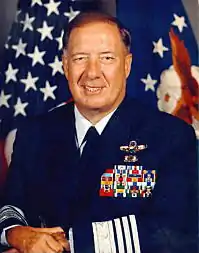
- Republic of Singapore Air Force[36] (until 1983)
- United States Air Force,[37][38] (1993 to 1994)
- Pakistan Air Force[39] (until 2006)
- Royal Air Force of Oman[40] (until the 1980s)
- Egyptian Air Force[41]
- Air Force of the Democratic Republic of the Congo[42] (1997–2010)
- Yemeni Air Force (South Yemen; South Arabian Air Force) (1970-1985)[43]
- Zaire Air Force[44] (1971–1997)
See also
Citations
- Hering, Peter George (1961). Customs and traditions of the Royal Air Force. Aldershot: Gale and Polden Ltd. pp. 21, 22. OCLC 462209238.
- "Commissioned Ranks of the Royal Air Force April 1918 - Aug 1919 Initial Uniform Design". Air of Authority. Retrieved 31 March 2017.
- "RAF AP 1358, CHAP 7 - DISTINGUISHING INSIGNIA" (PDF). MOD. 2 August 2010. Archived from the original (PDF) on 7 March 2017. Retrieved 31 March 2017.
- "Royal Australian Air Force / Royal Australian Air Force". Uniforminsignia.org. 2 August 2010. Retrieved 24 February 2013.
- "Royal New Zealand Air Force /". Uniforminsignia.org. 2 August 2010. Retrieved 24 February 2013.
- "Hellenic Air Force / Πολεμική Αεροπορία - Polemikí Aeroporía". Uniforminsignia.org. 2 August 2010. Retrieved 24 February 2013.
- "The Nigerian Air Force Service, Colours, Wings and Rank Structure". Nigerianairforce.net. Retrieved 24 February 2013.
- "Indian Air Force / भारतीय वायु सेना / Bhartiya Vāyu Senā". Uniforminsignia.org. 2 August 2010. Retrieved 24 February 2013.
- "Bangladesh Air Force / বাংলাদেশ বিমান বাহিনী - Bangladesh Biman Bahini". Uniforminsignia.org. 2 August 2010. Retrieved 24 February 2013.
- "Sri Lanka Air Force /". Uniforminsignia.org. 2 August 2010. Retrieved 24 February 2013.
- "Ghana Air Force /". Uniforminsignia.org. 16 December 2012. Retrieved 24 February 2013.
- "Air Force of Zimbabwe / Air Force of Zimbabwe". Uniforminsignia.org. 4 August 2010. Retrieved 24 February 2013.
- "Royal Thai Air Force / กองทัพอากาศไทย - Kong Thab Akat Thai". Uniforminsignia.org. 2 August 2010. Retrieved 24 February 2013.
- "Chilean Air Force / Fuerza Aérea de Chile". Uniforminsignia.org. 2 August 2010. Retrieved 24 February 2013.
- "Pakistan Air Force - PAF / پاک فضائیہ - Pak Fiza´ya". Uniforminsignia.org. 2 August 2010. Retrieved 24 February 2013.
- "Egyptian Air Force / القوات الجوية المصرية". Uniforminsignia.org. 2 August 2010. Retrieved 24 February 2013.
- "Afghan National Air Corps /". Uniforminsignia.org. 2 August 2010. Retrieved 24 February 2013.
- "Argentine Air Force / Fuerza Aérea Argentina". Uniforminsignia.org. 2 August 2010. Retrieved 24 February 2013.
- "Belgian Air Component / Luchtcomponent-Composante". Uniforminsignia.org. 2 August 2010. Retrieved 24 February 2013.
- "Eritrean Air Force /". Uniforminsignia.org. 2 August 2010. Retrieved 24 February 2013.
- "Finnish Air Force / Suomen ilmavoimat / Finska flygvapnet". Uniforminsignia.org. 2 August 2010. Retrieved 24 February 2013.
- (PDF) http://www.mil.se/attachments/the_facts_2006_2007_eng.pdf. Retrieved 1 March 2007. Missing or empty
|title=(help) - "Royal Malaysian Air Force / Tentera Udara DiRaja Malaysia". Uniforminsignia.org. 2 August 2010. Retrieved 24 February 2013.
- "Peruvian Air Force / Fuerza Aérea del Perú". Uniforminsignia.org. 2 August 2010. Retrieved 24 February 2013.
- "Royal Netherlands Air Force / Koninklijke Luchtmacht". Uniforminsignia.org. 2 August 2010. Retrieved 24 February 2013.
- "Royal Danish Air Force / Flyvevåbnet". Uniforminsignia.org. 2 August 2010. Retrieved 24 February 2013.
- "Air Force / Aeronautica Militare". Uniforminsignia.org. 2 August 2010. Retrieved 24 February 2013.
- "Romanian Air Force / Forţele Aeriene Române". Uniforminsignia.org. 2 August 2010. Retrieved 24 February 2013.
- "Romanian Air Force / Forţele Aeriene Române". Uniforminsignia.org. 2 August 2010. Retrieved 24 February 2013.
- "South African Air Force /". Uniforminsignia.org. 2 August 2010. Retrieved 24 February 2013.
- "Royal Canadian Air Force". Uniforminsignia.org. 5 May 2015. Retrieved 26 July 2017.
- "Irish Air Corps / Aer Chór na hÉireann". Uniforminsignia.org. 2 August 2010. Retrieved 24 February 2013.
- "Uruguayan Air Force / Fuerza Aérea Uruguaya". Uniforminsignia.org. 2 August 2010. Retrieved 24 February 2013.
- "Canadian Air Force / Canadian Forces Air Command - AIRCOM". Uniforminsignia.org. 2 August 2010. Retrieved 24 February 2013.
- "Royal Rhodesian Air Force /". Uniforminsignia.org. 2 August 2010. Retrieved 24 February 2013.
- "Republic of Singapore Air Force / 新加坡空军部队 - Angkatan Udara Republik Singapura - சிங்கப்பூர் ஆகாயப்படை". Uniforminsignia.org. 2 August 2010. Retrieved 24 February 2013.
- "U.S. Air Force / United States Air Force". Uniforminsignia.org. 2 August 2010. Retrieved 24 February 2013.
- Although the USAF discontinued the RAF-pattern rank insignia introduced by General Merrill McPeak in 1994, U.S. Air Force Academy, college & university Air Force Reserve Officer Training Corps, and Air Force Officer Training School officer cadets use identical insignia today.
- "Pakistan Air Force - PAF / پاک فضائیہ - Pak Fiza´ya". Uniforminsignia.org. 2 August 2010. Retrieved 24 February 2013.
- "Royal Air Force of Oman / al-Quwwat al-Jawwiya al-Sultanat Oman". Uniforminsignia.org. 2 August 2010. Retrieved 24 February 2013.
- "Air Force /". Uniforminsignia.org. 5 January 2013. Retrieved 24 February 2013.
- "Air Force of the Democratic Republic of the Congo / Force Aérienne du Congo". Uniforminsignia.org. 2 August 2010. Retrieved 24 February 2013.
- "Air Force /". Uniforminsignia.org. 5 January 2013. Retrieved 24 February 2013.
- "Air Force / Force Aérienne". Uniforminsignia.org. 2 August 2010. Retrieved 24 February 2013.
General references
- Hobart, Malcolm. Badges and Uniforms of the Royal Air Force. London/Barnsley, England: Leo Cooper/Pen & Sword Books Ltd., 2000. ISBN 0-85052-739-2.
